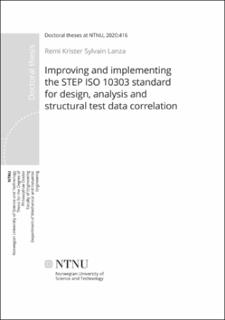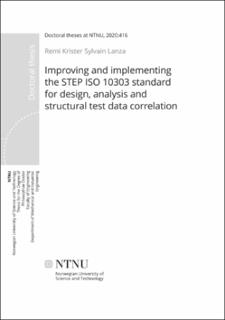| dc.contributor.advisor | Haenisch, Jochen | |
| dc.contributor.advisor | Rølvåg, Terje | |
| dc.contributor.author | Lanza, Remi Krister Sylvain | |
| dc.date.accessioned | 2020-12-04T08:31:16Z | |
| dc.date.available | 2020-12-04T08:31:16Z | |
| dc.date.issued | 2020 | |
| dc.identifier.isbn | 978-82-471-9676-2 | |
| dc.identifier.issn | 2703-8084 | |
| dc.identifier.uri | https://hdl.handle.net/11250/2711837 | |
| dc.description.abstract | The objective of this thesis was to improve the effectiveness of data management of physical test and simulation data, in the context of digital twins, PDM (Product Data Management)/PLM (Product Lifecycle Management) and SDM (Simulation Data Management).
Many different software applications, from different vendors are used for simulation, CAD (Computer Aided Design), PDM/PLM and other engineering activities. Most of them use different data storage formats and methods that are customized for the specific use of their application.
How can the lack of data interoperability among collaborating engineering applications be solved? Within and across companies sharing of data, for example, for creating and maintaining digital twins, becomes cumbersome when different parties use different applications. Files need to be converted, or tasks need to be re-done, potentially leading to loss of information. Managing project data becomes difficult, and with data originating from different sources, stored in different locations and companies, it is tough to keep track of what is where and in which version. This is especially important for digital twins, where different domain data need to be accessed by automatic processes.
This thesis addresses this problem specifically for the domains of FEM (Finite Element Method) and structural testing data. However, the fact that this is part of a larger context involving multiple other domains, is taken in consideration.
The STEP ISO 10303 standard is highly in focus throughout the study. This standard contains data models designed to cover as much as possible of the different engineering domains, across development life cycle stages.
The study shows how this standard can also be applied to represent and manage structuraltest data, including its relations to corresponding FEM analyses; this has never been done before. Implementations using and validating the new concepts were performed inconverter applications and in a SDM tool.
To increase the FEM domain coverage of the standard, certain extensions of the standard are recommended after having been implemented and validated as part of this thesis. With these extensions the standard can be used for nonlinear FEM analysis, thus, allowing also such advanced analysis data to be shared among FEM solvers. | en_US |
| dc.language.iso | eng | en_US |
| dc.publisher | NTNU | en_US |
| dc.relation.ispartofseries | Doctoral theses at NTNU;2020:416 | |
| dc.relation.haspart | Paper 1: Lanza, Remi Krister Sylvain; Haenisch, Jochen; Bengtsson, Kjell; Rølvåg, Terje. Relating structural test and FEA data with STEP AP209. Advances in Engineering Software 2019 ;Volum 127. s. 96-105 | en_US |
| dc.relation.haspart | Paper 2: Lanza, Remi Krister Sylvain; Haenisch, Jochen; Bengtsson, Kjell; Rølvåg, Terje. ISO 10303 AP209 - Why and how to embed nonlinear FEA. This article is awaiting submission and is therefore not included. | en_US |
| dc.relation.haspart | Paper 3: Lanza, Remi Krister Sylvain; Haenisch, Jochen; Bengtsson, Kjell; Rølvåg, Terje. Extending STEP AP209 for Nonlinear Finite Element Analysis. This article is awaiting submission and is therefore not included. | en_US |
| dc.relation.haspart | Paper 4: Bengtsson, Kjell; Haenisch, Jochen; Liestøl, Olav; Lanza, Remi. Open Simulation Data Management and Testing – The CRYSTAL Project. NAFEMS World Congress 2017. This paper is not included due to copyright restrictions. | en_US |
| dc.title | Improving and implementing the STEP ISO 10303 standard for design, analysis and structural test data correlation | en_US |
| dc.type | Doctoral thesis | en_US |
| dc.subject.nsi | VDP::Teknologi: 500 | en_US |

